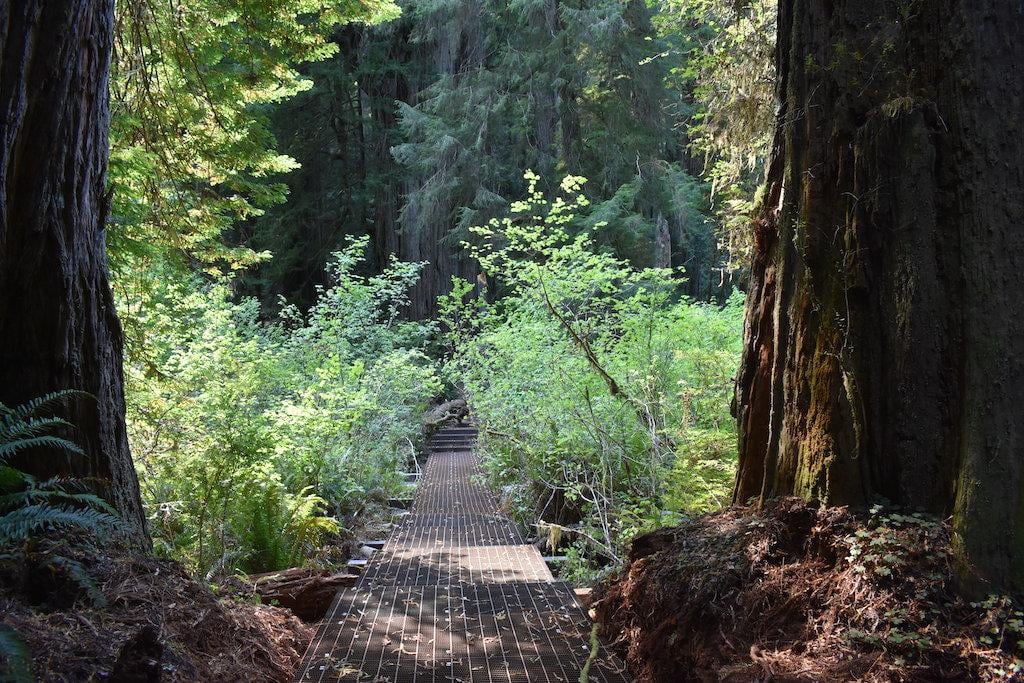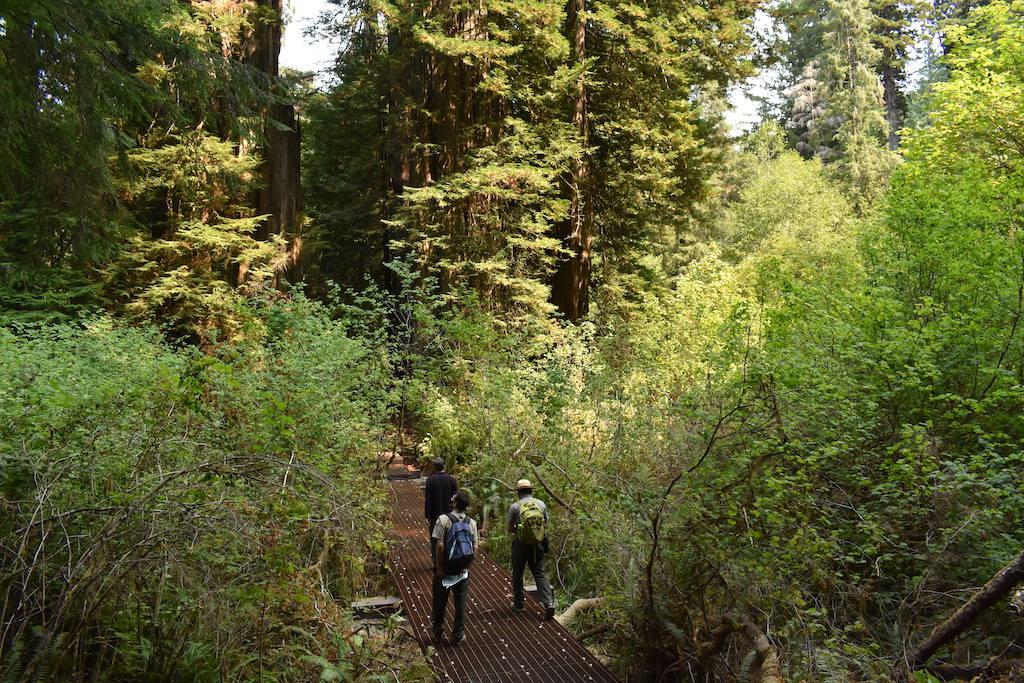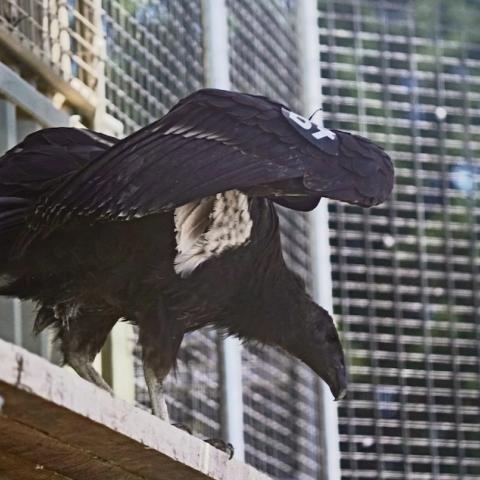
A new boardwalk through the Grove of the Titans in Redwood National and State Parks should be finished by summer 2021/California State Parks
“Walking in the redwoods, especially on a warm day, the first thing that hits me is the smell of the forest,” David Reed says.
As the development director for the Redwood Parks Conservancy, the nonprofit partner of Redwood National and State Parks in northern California, it’s an experience Reed knows well. “On the more frequent wet, foggy days, that smell is replaced by the earthy odors of mosses, ferns, and mushrooms along with the resinous aromas from the redwoods.”
This will soon be a sensory experience that more visitors will be able to have safely, now that a project to build a trail to one of the world’s most magnificent groves of redwoods is well under way.
Located in Jedediah Smith Redwoods State Park, the Grove of Titans—a collection of old-growth redwoods, including ten of the world’s largest trees—was hidden in plain sight, undiscovered by the hiking masses. Although the grove was known to indigenous people for centuries, it wasn’t until the 1990s, when researchers rediscovered the grove and its location was subsequently published, that curious trampers sought out these giant trees for themselves. The result was a network of unofficial “social” trails leading to and through the grove, as well as discarded toilet paper and other detritus because of the lack of facilities, that damaged vegetation, potentially threatened the trees’ shallow root systems, and created an unsightly scene.
The Conservancy, Save the Redwoods League, California State Parks, and the National Park Service are now partnering to build a 1,300-foot elevated walkway to the grove that connects with the park’s existing Mill Creek Trail, while replanting (and essentially removing) social trails, building parking and restrooms, and creating interpretive programming. Construction work has continued safely through the coronavirus pandemic, Reed says, and the project is expected to be completed in summer 2021. Funding for the project came mostly from private donations, state coffers, and a matching grant from Wild Tribute, a national-park-themed apparel company whose “4 the Parks” program donates 4 percent of its proceeds to park projects.

The boardwalk elevates visitors above marshy areas and is designed to eliminate social trails into the grove/California State Parks
Redwoods are incredibly resilient, Reed says, but the human impacts to the grove were already becoming obvious.
“The forest around the grove and the ecology around that area were getting beaten down,” Reed says. “The social trail system was looking like the L.A. freeway system. The trees are going to make it, but [the concern is] the animals and plants that rely on them, the understory, the trampled ferns….But that’s all coming back. The forest is finding its way back because there are less feet.”
The tallest trees on the planet, coastal redwoods (Sequoia sempervirens) are related to the giant sequoias of the central California interior, which are generally a bit shorter and squatter, as well as the dawn redwoods found in China. At one time, the native range of coastal redwoods covered some 2 million acres in California, and the fossil record indicates that Sequoia genus specimens were once found as far away as Europe and Asia.
The fibrous and deeply furrowed redwood bark can be up to two feet thick on the largest old-growth trees, thereby protecting the interior sapwood and heartwood from insects and fire. Redwoods have long been important to local indigenous people, too, such as the Chilula and Yurok; one Chilula elder quoted in Gail Jenner’s book Historic Redwood National and State Parks said that his people were “from within the redwood tree.”
Beginning in the mid-19th century, the trees were routinely felled by loggers to the point that only 5 percent, or fewer than 120,000 acres, of old-growth redwoods remain. More than half of this old-growth acreage is protected within Redwood National and State Parks—a federal-state partnership that jointly manages a conglomeration of nine parks that encompass a range of habitats. Prairies, coastline, freshwater ponds and wetlands, dune systems, historic and cultural sites, and of course redwood forests are all found in the parks, several of which share borders.
Brett Silver, the deputy district superintendent for the parks (a California State Parks employee, technically), says that maintaining and upgrading trails in general, and the Grove of Titans in particular, have been major priorities. “For a long time, we went with the strategy of not telling people where it was,” Silver says, referring to the Grove of Titans. “But once it was geotagged and you could look it up on Google Maps, we realized we had to make a change. People want to go there. People are telling us what they want. The [new] trail layout was based on what we were seeing from the unauthorized social trails.”

This closeup shows a group of plants growing out of a space between the trunks of two "titans."/California State Parks
Safety—for both people and trees—was a paramount concern as well. “You can dig six inches down and you can find the feeder roots of redwood trees,” Silver says. “A lot of the shallow roots will connect to each other and kind of tie into each other. These feeder roots take in a lot of nutrients, so when we build the trails, they’re built with a lot of rocks so water can filter down into the roots.” Exposed roots from the social trails were also slippery to walk on and were posing safety hazards for visitors, he says.
Now that the Grove of Titans project is under way, Silver hopes that this fundraising and outreach experience will lead to other trail improvement projects in the parks.
“One of the best ways to get people connected to the outdoors and the redwoods is to get them on the trails,” he says. “At Prairie Creek Redwoods alone, there are more than 70 miles of trails. How can we do an adopt-a-trail program or fundraisers? [Our partners] have come up with some interesting strategies. Grove of Titans has opened the door.”



 Support Essential Coverage of Essential Places
Support Essential Coverage of Essential Places







Comments
I found the grove in 2015 and definitely went off trail to find it. Since nothing but 'clues' were posted online, I was only able to find about half of the more famous titans. I returned in 2018 with more information. By that time there were GPS coordinates online (or at least I found them online), as well as unofficial maps. I was able to see everything and do as little forest floor damage as possible. Though the Grove still did not exist "officially", there was a Humboldt State University student team doing surveys of people leaving the grove area. Pretty sure I shocked them with how much I knew, including citing a 2014? Masters thesis on the Grove from a former student at Humboldt. It's like they couldn't imagine the lay public reading their literature.